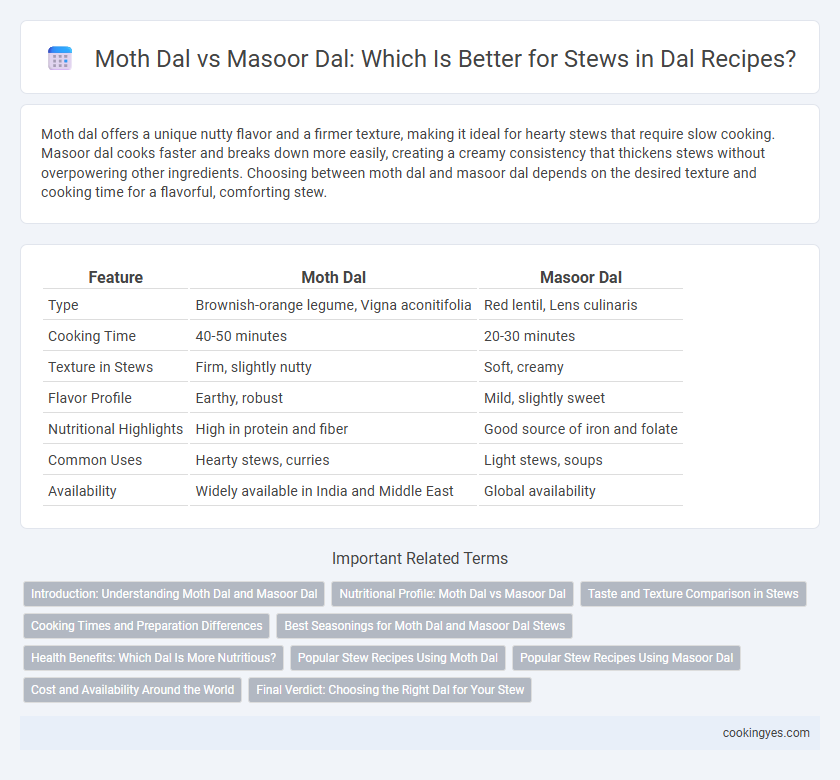Moth dal offers a unique nutty flavor and a firmer texture, making it ideal for hearty stews that require slow cooking. Masoor dal cooks faster and breaks down more easily, creating a creamy consistency that thickens stews without overpowering other ingredients. Choosing between moth dal and masoor dal depends on the desired texture and cooking time for a flavorful, comforting stew.
Table of Comparison
| Feature | Moth Dal | Masoor Dal |
|---|---|---|
| Type | Brownish-orange legume, Vigna aconitifolia | Red lentil, Lens culinaris |
| Cooking Time | 40-50 minutes | 20-30 minutes |
| Texture in Stews | Firm, slightly nutty | Soft, creamy |
| Flavor Profile | Earthy, robust | Mild, slightly sweet |
| Nutritional Highlights | High in protein and fiber | Good source of iron and folate |
| Common Uses | Hearty stews, curries | Light stews, soups |
| Availability | Widely available in India and Middle East | Global availability |
Introduction: Understanding Moth Dal and Masoor Dal
Moth Dal, derived from Vigna aconitifolia, is a nutrient-rich legume known for its slightly nutty flavor and high protein content, making it an excellent choice for hearty stews. Masoor Dal, or red lentils, cooks quickly and offers a mild, earthy taste along with abundant iron and fiber, contributing to a smoother stew texture. Both dals provide distinct nutritional benefits and culinary characteristics, influencing their ideal use in various stew recipes.
Nutritional Profile: Moth Dal vs Masoor Dal
Moth Dal contains higher protein content and essential amino acids, making it ideal for muscle repair and energy. Masoor Dal is rich in iron and folate, which supports blood health and aids in preventing anemia. Both dals provide significant dietary fiber that promotes digestive health, but Moth Dal offers a slightly lower glycemic index, benefiting blood sugar management in stews.
Taste and Texture Comparison in Stews
Moth Dal offers a nutty, slightly sweet flavor with a firm yet creamy texture that holds well in stews, making it ideal for recipes requiring distinct bean shapes and a hearty bite. Masoor Dal provides a milder, earthy taste and softens quickly, resulting in a smoother, more uniform stew consistency that readily absorbs spices. Choosing between Moth Dal and Masoor Dal depends on desired stew texture: Moth Dal for chunkier, textured dishes and Masoor Dal for velvety, soupy stews.
Cooking Times and Preparation Differences
Moth Dal requires a longer cooking time of about 45-60 minutes compared to Masoor Dal, which cooks in roughly 20-30 minutes, making Masoor Dal more suitable for quick stews. Moth Dal's firmer texture necessitates soaking before cooking to reduce cooking time and improve digestibility, whereas Masoor Dal can be cooked directly without soaking. The distinct preparation differences influence stew consistency and flavor absorption, with Moth Dal providing a nuttier taste and Masoor Dal offering a softer, creamier texture.
Best Seasonings for Moth Dal and Masoor Dal Stews
Moth Dal and Masoor Dal stews benefit from distinct seasonings to enhance their flavors; Moth Dal pairs well with cumin seeds, turmeric, garlic, and dried red chilies for a robust earthy taste, while Masoor Dal thrives with ginger, mustard seeds, coriander powder, and fresh green chilies to bring out its mild and slightly sweet profile. Fenugreek leaves and asafoetida complement Moth Dal by adding depth and reducing its natural bitterness, whereas garam masala and curry leaves elevate Masoor Dal with aromatic warmth and complexity. Balancing these seasonings optimizes the nutritional value and taste, making each stew unique and enjoyable.
Health Benefits: Which Dal Is More Nutritious?
Moth dal offers higher protein and fiber content compared to masoor dal, making it an excellent choice for heart health and digestive support in stews. Masoor dal, rich in iron and folate, provides vital nutrients for blood health and energy metabolism. Both dals are low in fat and calories, but moth dal's nutrient density makes it more beneficial for overall nutrition in hearty, nutritious stews.
Popular Stew Recipes Using Moth Dal
Moth Dal offers a unique nutty flavor and firm texture that holds well in stews, making it ideal for robust recipes like Moth Dal Curry and Spiced Moth Dal Stew. Unlike Masoor Dal, which cooks faster and produces a softer consistency, Moth Dal stands out in dishes requiring longer simmering, enhancing hearty, protein-rich stews popular in Indian and South Asian cuisine. Popular recipes such as Moth Dal Tadka and Moth Dal with Vegetables highlight its versatility and nutritional benefits in wholesome stew preparations.
Popular Stew Recipes Using Masoor Dal
Masoor Dal is widely favored in stew recipes for its quick cooking time and smooth texture that blends well with spices and vegetables. Popular stews like Masoor Dal Curry and Masoor Dal Tadka highlight its rich, earthy flavor and nutritional benefits, including high protein and iron content. Compared to Moth Dal, Masoor Dal creates a creamier stew, making it the preferred choice for hearty, flavorful dishes.
Cost and Availability Around the World
Moth Dal is generally more expensive and less widely available compared to Masoor Dal, especially outside South Asian countries. Masoor Dal benefits from broader global cultivation and distribution, making it a cost-effective choice for stews due to its affordability and consistent availability. Both dals offer distinct flavors, but cost-effectiveness and accessibility often make Masoor Dal the preferred ingredient in international markets.
Final Verdict: Choosing the Right Dal for Your Stew
Moth Dal offers a nutty flavor and firm texture, making it ideal for hearty stews that require longer cooking times, while Masoor Dal cooks faster and provides a creamy consistency, perfect for smoother, lighter stews. Nutritionally, Moth Dal is rich in protein and fiber, supporting digestion and sustained energy, whereas Masoor Dal is a great source of iron and folate, benefiting blood health. Choosing between Moth Dal and Masoor Dal depends on your stew's desired texture and nutritional goals, with Moth Dal favoring robust, textured dishes and Masoor Dal suited for quick, velvety soups.
Moth Dal vs Masoor Dal for Stews Infographic

 cookingyes.com
cookingyes.com